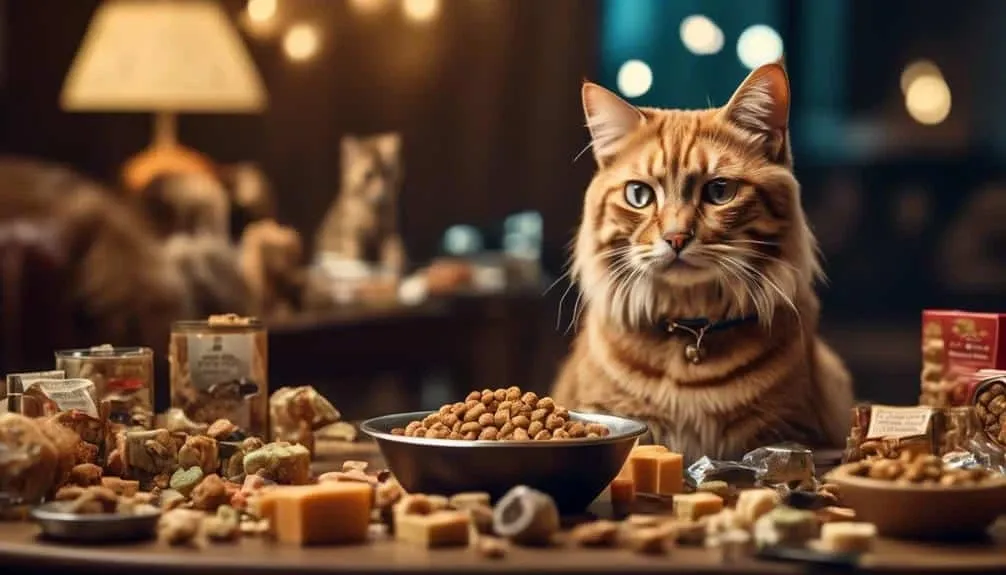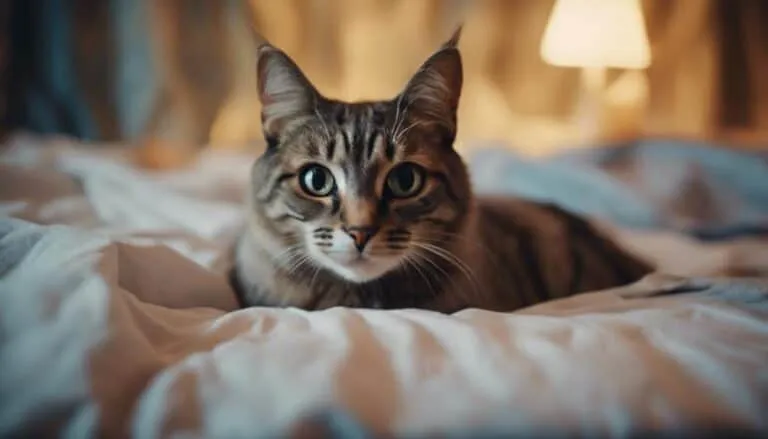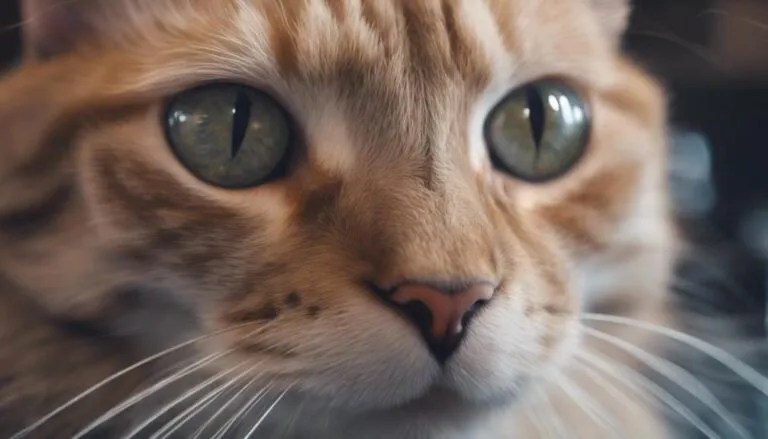The Best Fluffy Pancakes recipe you will fall in love with. Full of tips and tricks to help you make the best pancakes.

Are you curious about the mysterious reasons behind your cat's sudden disinterest in their dry food? Well, you're in for a treat (no pun intended).
There are some troubling explanations that might shed some light on this puzzling behavior. From changes in the food itself to dental issues, stress, and medical conditions, there could be a multitude of factors at play.
So, let's unravel the enigma and discover why your feline friend might be snubbing their once beloved kibble.
Key Takeaways
- Changes in recipe, texture, or freshness of dry food can cause cats to reject it.
- Lack of exposure to dry food, especially in adult or senior cats, can lead to reluctance in eating it.
- Dental issues, such as dental disease or oral cavity problems, can make chewing painful and result in rejection of dry food.
- Environmental stress, including changes in the household or presence of stressors, can cause decreased appetite in cats.
Recipe or Ingredient Changes
If your cat is snubbing dry food, one possible reason could be changes in the recipe or ingredients. Cats are known for their discerning palates, and even small alterations to their food can affect their willingness to eat it.
When considering recipe or ingredient changes, it's important to explore potential discussion ideas such as nutritional value implications and allergies or sensitivities. Changes in the recipe may impact the overall nutritional value of the dry food, which can be a crucial factor in maintaining your cat's health.
Additionally, some cats may have allergies or sensitivities to certain ingredients, leading to their rejection of the food. It's essential to carefully examine the recipe or ingredients to ensure they're suitable for your cat's dietary needs and preferences.
Shape or Texture Change
When it comes to your cat snubbing dry food, there are several factors to consider. One important factor is a potential change in the shape or texture of the kibble. Cats can be quite particular about the shape and texture of their food, and any alteration in these aspects can cause them to turn up their nose.
Here are some possible discussion ideas about the subtopic 'shape or texture change':
- Effects of shape changes on cats' eating behavior: Explore how different shapes of kibble can affect a cat's ability to pick up and chew their food. Discuss whether certain shapes are more appealing to cats and how shape changes can impact their overall eating experience.
- How to address texture-related food aversions in cats: Provide tips and strategies for helping cats overcome aversions to certain textures in their dry food. Discuss methods such as gradually introducing new textures, mixing wet food with dry food, or seeking alternative options that still meet their nutritional needs.
- The importance of maintaining consistency in shape and texture: Emphasize the significance of keeping the shape and texture of a cat's dry food consistent to ensure their continued enjoyment and acceptance of the food. Discuss potential consequences of frequent shape or texture changes, such as the cat developing aversions or refusing to eat altogether.
Food Left Out Too Long
Food left out for extended periods of time can contribute to a cat's rejection of dry food. When dry food is left out for too long, it can have a negative impact on its palatability, making it less appealing to cats. Dry food that has been exposed to air and moisture for extended periods can become stale and lose its flavor.
This can be especially problematic for picky eaters who are sensitive to changes in taste and texture. Additionally, leaving dry food out for long periods creates an environment conducive to bacterial growth. Bacteria can multiply rapidly on moist and warm surfaces, potentially causing foodborne illnesses in cats.
Therefore, it's important to store dry food properly, in a cool and dry place, and to discard any food that has been left out for too long to ensure the health and well-being of your feline companion.
Freshness Issues
To ensure the optimal quality and palatability of dry cat food, it's crucial to address potential freshness issues. Here are some possible discussion ideas about freshness issues:
- Importance of checking the expiration date of dry food:
It's essential to check the expiration date on the packaging before feeding your cat. Expired dry food may not only lose its nutritional value but also become less appealing to your feline friend.
- Tips for storing dry food properly to maintain freshness:
Proper storage is key to preserving the freshness of dry cat food. Here are a few tips to follow:
- Store the food in a cool, dry place away from sunlight and moisture.
- Keep the food in its original packaging or transfer it to an airtight container to prevent exposure to air and potential contamination.
- Avoid buying excessive amounts of dry food at once to minimize the chances of it going stale before consumption.
Picky Eaters and Small Changes
Cats with picky eating habits can be easily deterred by even minor alterations in the texture or composition of their dry food. If your cat is a picky eater, there are ways to entice them to eat dry food.
One tip is to gradually introduce the new food by mixing it with their current food. Start with a small amount and increase the ratio of dry food over time.
Another suggestion is to try different flavors or brands of dry food to find one that your cat prefers.
Additionally, you can try warming the dry food slightly or adding a small amount of water to make it more appealing.
Remember to be patient and consistent in your approach, as it may take time for your picky cat to adjust to the changes.
Lack of Exposure to Dry Food
Lack of familiarity with dry food can contribute to a cat's reluctance to consume it. Adult or senior cats may not be familiar with dry food because previous owners may have only fed them canned or human food. Cats may have difficulty adjusting to the crunchy texture or taste of dry food, even non-picky cats may struggle with unfamiliar dry food.
Lack of exposure to dry food can lead to reluctance in eating it. To introduce dry food to adult cats, it's important to follow certain strategies for transitioning them. Start by mixing a small amount of dry food with their current food and gradually increase the proportion of dry food over time.
Providing a variety of dry food options and offering treats as rewards can also help in familiarizing cats with dry food.
Canned or Human Food Only
Feeding cats exclusively with canned or human food can contribute to their aversion to dry food. While cats may enjoy the taste and texture of canned or human food, it's important to understand the importance of a balanced diet for their overall health and well-being.
Dry food provides essential nutrients and helps maintain dental health by promoting chewing. Transitioning cats to a dry food diet may require patience and gradual introduction. Start by mixing small amounts of dry food with their current diet and gradually increase the proportion of dry food over time.
It's essential to monitor their eating habits and ensure they're consuming enough calories and nutrients. Consulting with a veterinarian can provide guidance and support throughout the transition process. Remember, a balanced diet is crucial for the long-term health of our feline companions.
Difficulty Adjusting to Crunchy Texture
When exclusively fed with canned or human food, cats may struggle with adjusting to the crunchy texture of dry food. This difficulty can be attributed to various factors, including dental health and the transitioning process for senior cats.
Here are three reasons why cats may have trouble adjusting to the crunchy texture of dry food:
- Dental health and crunchy texture: Cats with dental issues, such as dental disease or oral pain, may find it uncomfortable to chew on dry food. Signs of dental problems can include drooling, blood in food/water bowls, and a foul odor from the mouth. A veterinary visit is recommended if dental pain is suspected.
- Transitioning to dry food for senior cats: Older cats that have been primarily fed with canned or human food may have a hard time adjusting to the crunchy texture of dry food. Lack of exposure to this type of food can lead to reluctance in eating it. Gradual transitioning, mixing dry food with familiar wet food, can help ease the adjustment process.
- Unfamiliar taste and texture: Even non-picky cats may struggle with the unfamiliar taste and texture of dry food. Cats are known for their preference for moist and soft food, so the crunchy texture can take some getting used to. Patience and persistence in offering dry food can help encourage acceptance over time.
Understanding these reasons can help cat owners address the issue and find ways to introduce dry food successfully into their feline companion's diet.
Unfamiliar Dry Food
Introducing a new type of dry food to your cat's diet can be a gradual process that requires patience and persistence. This is especially true for senior cats who may not be familiar with dry food.
It's important to understand that cats can be picky eaters and may resist trying unfamiliar dry food. To overcome this resistance, you can try mixing small amounts of the new dry food with their current food, gradually increasing the proportion of the new food over time.
Additionally, you can try offering different flavors or textures to entice their interest. It's important to note that some cats may simply prefer wet food or have difficulty adjusting to the crunchy texture of dry food.
Reluctance Due to Lack of Exposure
To address the issue of reluctance due to lack of exposure, it's crucial to understand that cats may have limited familiarity with dry food, especially if they weren't previously introduced to it or if they've only been fed canned or human food. Adjusting to new textures can be challenging for cats, particularly senior cats who may have never encountered dry food before.
Here are three reasons why cats may be reluctant to eat dry food due to lack of exposure:
- Lack of familiarity: Cats may be hesitant to try dry food if they've never been exposed to it before, as they may be unsure about the taste and texture.
- Preference for previous diet: Cats who've only been fed canned or human food may have developed a strong preference for these types of food, making it difficult to transition to dry food.
- Difficulty in chewing: Senior cats may have dental issues that make chewing dry food painful or uncomfortable, leading to their reluctance to eat it.
Understanding these reasons can help cat owners find ways to gradually introduce and encourage their feline friends to embrace dry food as part of a balanced diet.
Frequently Asked Questions
What Are Some Signs That My Cat May Be Experiencing Dental Issues That Are Causing Them to Reject Dry Food?
If your cat is rejecting dry food, signs of dental issues may include picking up and dropping kibble, drooling, blood in food/water bowls, and a foul odor from the mouth. A veterinary visit is recommended to address dental pain.
How Can Environmental Stressors Contribute to a Cat's Refusal to Eat Dry Food?
Environmental stressors can impact a cat's willingness to eat dry food. Changes in the household or exposure to new noises can cause behavioral changes, leading to a refusal to eat. Veterinary guidance can help address these issues.
What Are Some Other Signs of Stress in Cats Besides a Decreased Appetite?
Signs of stress in cats, besides a decreased appetite, include inappropriate urination, hiding, overgrooming. Dental issues, environmental stressors, and medical conditions can contribute to a cat's refusal to eat dry food, posing dangers to their health.
What Medical Conditions Could Be Causing My Cat to Stop Eating Dry Food?
If your cat stops eating dry food, it could be due to medical conditions. Illnesses like renal issues, hepatic lipidosis, or dental problems can cause a decreased appetite. Prompt veterinary attention is necessary to prevent potential dangers.
What Are the Potential Dangers of a Cat Completely Refusing to Eat?
If your cat completely refuses to eat, potential health risks include weight loss, nutritional deficiencies, and the development of hepatic lipidosis. Consider alternative food options such as canned or wet food to ensure adequate nutrition.
Conclusion
In conclusion, understanding the reasons behind why cats snub dry food is crucial for their overall health and well-being.
Whether it's due to changes in recipe or ingredients, shape or texture preferences, freshness issues, dental discomfort, or environmental stressors, addressing these factors can help ensure your feline companion's dietary preferences are met.
Remember, if your cat stops eating altogether, seeking prompt veterinary attention is necessary.
By staying informed and proactive, you can provide the best possible care for your cat.








